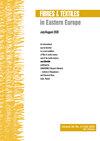Removal of Zinc Ions from Aqueous Solutions with the Use of Lignin and Biomass Part II
IF 0.9
4区 工程技术
Q3 MATERIALS SCIENCE, TEXTILES
引用次数: 0
Abstract
Abstract In response to the trend toward sustainable management of by-products from the pulp and paper industry as well as plant waste, practical and economical methods are being developed to use them in a way that does not pose a threat to the environment. The main aim of the research was to study the possibility of using lignin and plant biomass as biosorbents for the removal of zinc ions from aqueous solutions. The secondary aim was to build an optimal multilayer system made of biosorbents selected during the research in order to obtain the highest sorption efficiency and to determine the best conditions of the sorption process. The effectiveness of zinc ion sorption was assessed using an appropriate combination of sorbents such as lignin, oat bran, rice husk, chitosan, pectin, sodium alginate, pine bark, coconut fiber and activated carbon, selected on the basis of literature data and the preliminary results of tests carried out using FTIR and AAS. The main component of the sorption system was lignin separated from black liquor. Results indicate that the best Zn sorption system was based on coconut fiber, lignin, and pine bark, for which the maximum sorption efficiency was 95%. The research also showed that the increase in the process temperature, the mass of biosorbents used and the alkaline pH are the factors that increase the efficiency of the sorption. It can be concluded that lignin and plant biomass can be used as ecological sorbents of zinc ions from water solutions. They are safe for the environment, produced from renewable sources, and are by-products or waste materials, which is part of the sustainable development and circular economy currently promoted in the EU.利用木质素和生物质去除水溶液中的锌离子(二)
摘要为了应对纸浆和造纸工业副产品以及植物废物的可持续管理趋势,正在开发实用和经济的方法,以不对环境构成威胁的方式使用它们。本研究的主要目的是研究利用木质素和植物生物质作为生物吸附剂从水溶液中去除锌离子的可能性。第二个目标是建立一个由研究过程中选择的生物吸附剂制成的最佳多层系统,以获得最高的吸附效率并确定吸附过程的最佳条件。根据文献数据和FTIR和AAS测试的初步结果,使用合适的吸附剂组合,如木质素、燕麦麸、稻壳、壳聚糖、果胶、藻酸钠、松树皮、椰子纤维和活性炭,评估锌离子吸附的有效性。吸附系统的主要成分是从黑液中分离出的木质素。结果表明,椰子纤维、木质素和松树皮对锌的吸附效果最好,最大吸附效率为95%。研究还表明,工艺温度的升高、所用生物吸附剂的质量和碱性pH是提高吸附效率的因素。结果表明,木质素和植物生物质可以作为锌离子的生态吸附剂。它们对环境是安全的,由可再生资源生产,是副产品或废料,这是欧盟目前推动的可持续发展和循环经济的一部分。
本文章由计算机程序翻译,如有差异,请以英文原文为准。
求助全文
约1分钟内获得全文
求助全文
来源期刊

Fibres & Textiles in Eastern Europe
工程技术-材料科学:纺织
CiteScore
1.60
自引率
11.10%
发文量
12
审稿时长
13.5 months
期刊介绍:
FIBRES & TEXTILES in Eastern Europe is a peer reviewed bimonthly scientific journal devoted to current problems of fibre, textile and fibrous products’ science as well as general economic problems of textile industry worldwide. The content of the journal is available online as free open access.
FIBRES & TEXTILES in Eastern Europe constitutes a forum for the exchange of information and the establishment of mutual contact for cooperation between scientific centres, as well as between science and industry.
 求助内容:
求助内容: 应助结果提醒方式:
应助结果提醒方式:


